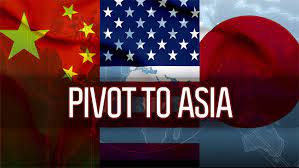Description

Copyright infringement is not intended
Story so far: U.S. Secretary of State is currently on his maiden trip across Southeast Asia, which includes meetings in Indonesia, Malaysia and Thailand.
- This visit signals Washington’s sustained interest in having strong ties with countries in the region even as tensions with China continue to mount across different policy issues.
U.S. ‘Asia pivot’ or ‘regional rebalancing’:
- Under this strategic approach Washington would seek to deepen ties with likeminded Asian nations.
- While the unstated goal of balancing the aggressive rise of China as a regional hegemon would very much be a driving force shaping the nature of the parleys.
- A wide range of policy subjects are included within the framework of this strategic thrust, including maritime security, technology, public health and biosecurity, trade and investment and climate change, to mention some of the important ones.
- Present U.S. approach is focussing more on economic competition with China rather than strategic confrontation.
What specific goals is Washington pursuing in Asia?
- S. administration now focus on soft power to forge agreements in areas of policy such as maritime cooperation and education and Peace Corps exchanges.
- The White House is seeking to leverage the opportunities for cooperation and international assistance that have opened during the pandemic, including as regarding vaccine supply.
- S. agenda for Asia is sharply focused on advocating for human rights.
What are the major challenges facing U.S. strategic policy in Asia?
Trade gap
- The major challenge for Washington is on the economic front, where it is seen as lacking a broad Asia economic strategy.
- Contrarily, China’s trade with every country across the Indo-Pacific region almost uniformly surpasses U.S. trade with the same, as the U.S. is not party to the two mega-trade pacts in Asia , the Regional Comprehensive Economic Partnership (RCEP) and the Comprehensive and Progressive Agreement for Trans-Pacific Partnership (CPTPP).
China’s BRI
- China has steamed ahead across the region, through the Belt and Road Initiative, which focuses on construction of infrastructure including roads, railways, and ports. Laos, Vietnam, and Indonesia, for example, have in recent months completed such infrastructure projects with financial support from Beijing, including high-speed railways, metro lines, dams, highways, and power plants.
South China sea
- China’s aggressive actions in the South China Sea, and its fraught relationship with Taiwan.
- Beijing is alleged to have deployed anti-ship and surface-to-air missiles in this sensitive arena, disregarding a decision in 2016 of an international tribunal that China’s claim over most of (the South China Sea) did not have any historical or legal basis.
https://www.thehindu.com/news/international/explained-understanding-the-us-strategy-of-asia-pivot/article37995079.ece?homepage=true











